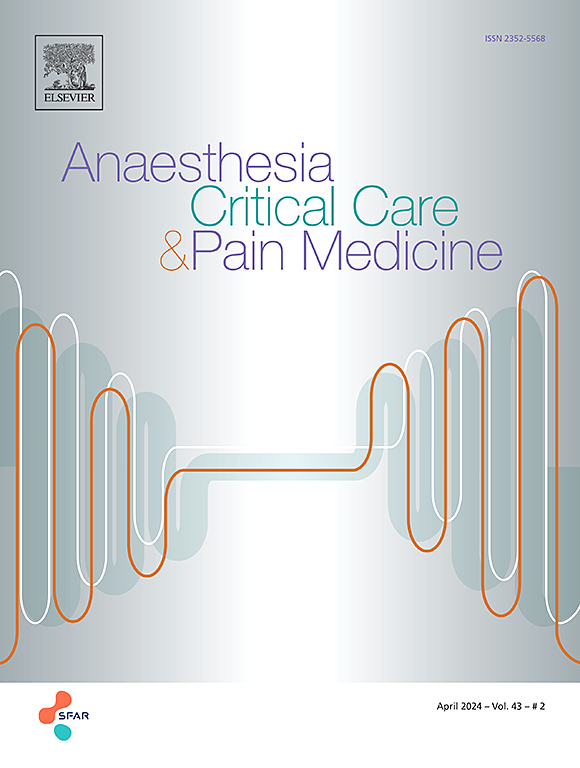非外伤性蛛网膜下腔出血后从外脑室引流中脱机:快速与渐进脱机并预测关闭试验失败。sevve回顾性多中心队列研究。
IF 3.7
3区 医学
Q1 ANESTHESIOLOGY
引用次数: 0
摘要
背景:蛛网膜下腔出血(SAH)后从外心室引流(EVD)中脱机通常需要进行EVD关闭试验,直接(快速脱机)或EVD逐渐升高(逐渐脱机)后进行。我们想比较这两种方法,并建立一个疮来预测闭合试验失败。方法:在成人SAH患者中,这项多中心(n = 5)回顾性研究比较了快速和渐进EVD断奶方法,并通过logistic回归确定与EVD关闭试验失败相关的因素。通过将数据集分成训练集(2/3)和测试集(1/3),我们开发了一个分数来预测关闭试验失败。结果:在2018年1月1日至2022年12月31日期间的1141例EVD患者中,407例因SAH住院并至少尝试过一次EVD脱机,249例(61%)采用渐进脱机,158例(39%)采用快速脱机。快速脱机与更多的失败相关(72例(46%)vs。86例(35%,p = 0.044),但ICU和医院的住院时间(LOS)均较短。EVD关闭试验失败与EVD维持时间延长独立相关(p结论:EVD断奶策略因中心而异。快速脱机与闭合试验失败的高风险相关,但与较短的LOS相关。EVD闭合试验失败与较差的结果相关。一个简单的3个标准评分会有所帮助。本文章由计算机程序翻译,如有差异,请以英文原文为准。
Weaning from external ventricular drainage after non-traumatic subarachnoid hemorrhage: Rapid vs. gradual weaning and predicting closure trial failure. The SEVDVE retrospective multicenter cohort study
Background
Weaning from external ventricular drainage (EVD) following subarachnoid hemorrhage (SAH) typically requires an EVD closure trial, performed either straightforwardly (rapid weaning) or after gradual elevation of EVD (gradual weaning). We wanted to compare these two methods and build a sore to predict closure trial failure.
Methods
Among adult SAH patients, this multicenter (n = 5) retrospective study, compared rapid and gradual EVD weaning methods, and identified factors associated with EVD closure trial failure through logistic regressions. We developed a score to predict closure trial failure by splitting the dataset into training (2/3) and testing (1/3) sets.
Results
Among 1141 patients with an EVD between 01/01/2018 and 12/31/2022, 407 were hospitalized for SAH and had at least one EVD weaning attempt, 249 (61%) underwent gradual and 158 (39%) rapid weaning. Rapid weaning was associated with more failure (72 (46%) vs. 86 (35%), p = 0.044), but shorter length of stay (LOS) in both ICU and hospital. EVD closure trial failure was independently associated with prolonged EVD maintenance (p < 0.001), prolonged ICU (p = 0.001) and hospital LOS (p = 0.05). We developed a failure closure score using the difference in intracranial pressures (from H0 to H3 after closure), time since EVD insertion, and EVD level. The model’s area under the receiver operating curve was 0.63 [0.53–0.74], indicating fair discrimination ability.
Conclusions
EVD weaning strategies vary across centres. Rapid weaning was associated with a high risk of closure trial failure, but shorter LOS. EVD closure trial failure was associated with worse outcomes. A simple 3-criteria score could help.
求助全文
通过发布文献求助,成功后即可免费获取论文全文。
去求助
来源期刊

Anaesthesia Critical Care & Pain Medicine
ANESTHESIOLOGY-
CiteScore
6.70
自引率
5.50%
发文量
150
审稿时长
18 days
期刊介绍:
Anaesthesia, Critical Care & Pain Medicine (formerly Annales Françaises d''Anesthésie et de Réanimation) publishes in English the highest quality original material, both scientific and clinical, on all aspects of anaesthesia, critical care & pain medicine.
 求助内容:
求助内容: 应助结果提醒方式:
应助结果提醒方式:


